Annual Report 2015
Financial Stability
The Federal Reserve promotes financial stability through its supervision and regulation of financial institutions; coordination of activities with domestic agencies through the Financial Stability Oversight Council (FSOC) and directly; and efforts to engage the global community in monitoring, supervision, and regulation that limit the risk and consequences of financial instability domestically and abroad.
A central tenet of the Federal Reserve's efforts in this area is the adoption of a macroprudential approach to supervision and regulation. Whereas a traditional--or microprudential--approach to supervision and regulation focuses on the safety and soundness of individual institutions, the macroprudential approach centers on the stability of the financial system as a whole.
In particular, the macroprudential approach informs the supervision of systemically important financial institutions, including large bank holding companies (BHCs), the U.S. operations of certain foreign banking organizations (FBOs), and financial market utilities (FMUs). In addition, the Federal Reserve serves as a "consolidated supervisor" of nonbank financial companies that have been designated by the FSOC as institutions whose distress or failure could pose a threat to the stability of the U.S. financial system as a whole (see "Financial Stability Oversight Council Activities" later in this section).
Furthermore, the changing nature of risks and fluctuations in financial markets and the broader economy require timely monitoring of conditions in domestic and foreign financial markets, among financial institutions, and in the nonfinancial sector in order to identify the buildup of vulnerabilities that might require further study or policy action.
Promotion of financial stability strongly complements the primary goals of monetary policy--price stability and full employment. A smoothly operating financial system promotes the efficient allocation of saving and investment, facilitating economic growth and employment. And price stability contributes not only to the efficient allocation of resources in the real economy, but also to reduced uncertainty and efficient pricing in financial markets, thereby supporting financial stability.
This section discusses key financial stability activities undertaken by the Federal Reserve in 2015, which include monitoring risks to financial stability; macroprudential supervision and regulation of large, complex financial institutions; and domestic and international cooperation and coordination.
Some of these activities are also discussed elsewhere in this annual report. A broader set of economic and financial developments are discussed in section 2, "Monetary Policy and Economic Developments," with the discussion that follows concerning surveillance of economic and financial developments focused on financial stability. The full range of activities associated with supervision of systemically important financial institutions, designated nonbank companies, and designated FMUs is discussed in section 4, "Supervision and Regulation."
Monitoring Risks to Financial Stability
In this Section:
Financial institutions are linked together through a complex set of relationships, and their condition depends on the economic condition of the nonfinancial sector. In turn, the condition of the nonfinancial sector is linked to the strength of financial institutions' balance sheets because the nonfinancial sector borrows from the financial sector. Research on financial stability is aimed at better understanding these complex linkages and has been an important part of Federal Reserve efforts in pursuit of overall economic stability (see box 1 for information on recent research).
In order to understand the interaction among these factors and consider appropriate policy responses, the Federal Reserve maintains a flexible, forward-looking financial stability monitoring program to help inform policymakers of the financial system's vulnerabilities to a range of potential adverse events or shocks. Such a monitoring program is a critical part of a broader program in the Federal Reserve System to assess and address vulnerabilities in the U.S. financial system.
Federal Reserve Board staff regularly assess a standard set of vulnerabilities relevant for financial stability: asset valuations and risk appetite, leverage in the financial system, liquidity risks and maturity transformation by the financial system, and borrowing by the nonfinancial sector (households and nonfinancial businesses). These monitoring efforts inform internal discussions concerning both macroprudential supervision and regulatory policies and monetary policy. They also inform Federal Reserve interactions with broader monitoring efforts, such as those by the FSOC and the Financial Stability Board (FSB).
The more specific discussion that follows focuses on a subset of the most important developments over the course of 2015 concerning specific indicators, including asset valuations and risk appetite, leverage, maturity and risk transformation, and nonfinancial-sector borrowing.
Box 1. 2015 Research on Financial Stability
The macroprudential approach to ensuring financial stability builds on a substantial and growing body of research on the factors that lead to vulnerabilities in the financial system and how policies can mitigate such risks.
It remains the case, however, that understanding of the array of factors important for financial stability is incomplete and evolving. As a result, the Federal Reserve engages actively in financial stability research. This research seeks to improve understanding of related issues, engages the broader research community in policy issues, and often involves collaboration with academia and researchers at other domestic and international institutions.
Finally, research efforts by Federal Reserve staff reflect their attempts to identify and grapple with topics of concern to the Federal Reserve, and the views expressed are those of the individual authors and not those of the Federal Reserve. Examples of research on financial stability in 2015 include the following:
- Identifying and measuring threats to financial stability. Three research notes and a working paper developing measurement aspects of a forward-looking monitoring program to identify and track time-varying sources of systemic risk. The program distinguishes between shocks, which are difficult to prevent, and the vulnerabilities that amplify shocks, which can be addressed. Drawing on a substantial body of research, the authors identify leverage, maturity transformation, interconnectedness, complexity, and the pricing of risk as the primary vulnerabilities in the financial system. The monitoring program tracks these vulnerabilities in four sectors of the economy: asset markets, the banking sector, shadow banking, and the nonfinancial sector. Developments in 2015 include a method that applies fixed criteria (that is, a static algorithm) to a medium-sized set of indicators covering a fairly wide range of financial activities, a taxonomy of measures of interconnectedness, and a more disaggregated analysis of the ratio of credit to gross domestic product for implementing macroprudential policies.1
- Quantifying the aggregate effects of banking-sector losses. A working paper summarizing the results of a research program at the Federal Reserve using tools in macroeconomics to derive quantitative estimates of the effect of capital shortfalls in the financial sector on aggregate economic activity. The macro spillover effects of capital shortfalls in the financial-intermediation sector are compared across five dynamic equilibrium models for policy analysis. Although all of the models considered share antecedents and a methodological core, each model emphasizes different transmission channels. This research program delivers "model-based confidence intervals" for the real and financial effects of shocks originating in the financial sector.2
- The interplay of monetary and macroprudential policies. A working paper examining the relative contribution of monetary and macroprudential policies as tools to achieve financial stability by estimating a quantitative general-equilibrium model with nominal rigidities and financial intermediation.3
- Interest rates, secondary-market liquidity, and firm access to debt markets. Two working papers studying the implications of nonconventional monetary policies and secondary-market liquidity for firm debt-financing decisions.4
- The real effect of credit contractions. Two forthcoming journal articles studying empirically the effects of credit contractions on the broader economy.5
1. See David Aikman, Michael Kiley, Seung Jung Lee, Michael Palumbo, and Missaka Warusawitharana (2015), "Mapping Heat in the U.S. Financial System: A Summary," FEDS Notes (Washington: Board of Governors of the Federal Reserve System, August 5), www.federalreserve.gov/econresdata/notes/feds-notes/2015/mapping-heat-in-the-us-financial-system-a-summary-20150805.html; David Aikman, Michael T. Kiley, Seung Jung Lee, Michael G. Palumbo, and Missaka N. Warusawitharana (2015), "Mapping Heat in the U.S. Financial System," Finance and Economics Discussion Series 2015-059 (Washington: Board of Governors of the Federal Reserve System, June), http://dx.doi.org/10.17016/FEDS.2015.059 ![]() ; Gazi Kara, Mary Tian, and Margaret Yellen (2015), "Taxonomy of Studies on Interconnectedness," FEDS Notes (Washington: Board of Governors of the Federal Reserve System, July 31), www.federalreserve.gov/econresdata/notes/feds-notes/2015/taxonomy-of-studies-on-interconnectedness-20150731.html; and William Bassett, Ainsley Daigle, Rochelle Edge, and Gazi Kara (2015), "Credit-to-GDP Trends and Gaps by Lender- and Credit-Type," FEDS Notes (Washington: Board of Governors of the Federal Reserve System, December 3), www.federalreserve.gov/econresdata/notes/feds-notes/2015/credit-to-gdp-trends-and-gaps-by-lender-and-credit-type-20151203.html. Return to text
; Gazi Kara, Mary Tian, and Margaret Yellen (2015), "Taxonomy of Studies on Interconnectedness," FEDS Notes (Washington: Board of Governors of the Federal Reserve System, July 31), www.federalreserve.gov/econresdata/notes/feds-notes/2015/taxonomy-of-studies-on-interconnectedness-20150731.html; and William Bassett, Ainsley Daigle, Rochelle Edge, and Gazi Kara (2015), "Credit-to-GDP Trends and Gaps by Lender- and Credit-Type," FEDS Notes (Washington: Board of Governors of the Federal Reserve System, December 3), www.federalreserve.gov/econresdata/notes/feds-notes/2015/credit-to-gdp-trends-and-gaps-by-lender-and-credit-type-20151203.html. Return to text
2. See Luca Guerrieri, Matteo Iacoviello, Francisco B. Covas, John C. Driscoll, Michael T. Kiley, Mohammad Jahan-Parvar, Albert Queralto Olive, and Jae W. Sim (2015), "Macroeconomic Effects of Banking Sector Losses across Structural Models," Finance and Economics Discussion Series 2015-044 (Washington: Board of Governors of the Federal Reserve System, June), http://dx.doi.org/10.17016/FEDS.2015.044 ![]() . Return to text
. Return to text
3. See Michael T. Kiley and Jae Sim (2015), "Optimal Monetary and Macroprudential Policies: Gains and Pitfalls in a Model of Financial Intermediation," Finance and Economics Discussion Series 2015-078 (Washington: Board of Governors of the Federal Reserve System, September), http://dx.doi.org/10.17016/FEDS.2015.078 ![]() . Return to text
. Return to text
4. See Sirio Aramonte, Seung Jung Lee, and Viktors Stebunovs (2015), "Risk Taking and Low Longer-Term Interest Rates: Evidence from the U.S. Syndicated Loan Market," Finance and Economics Discussion Series 2015-068 (Washington: Board of Governors of the Federal Reserve System, July), http://dx.doi.org/10.17016/FEDS.2015.068 ![]() ; and David M. Arseneau, David E. Rappoport, and Alexandros Vardoulakis (2015), "Secondary Market Liquidity and the Optimal Capital Structure," Finance and Economics Discussion Series 2015-031 (Washington: Board of Governors of the Federal Reserve System, May), http://dx.doi.org/10.17016/FEDS.2015.031
; and David M. Arseneau, David E. Rappoport, and Alexandros Vardoulakis (2015), "Secondary Market Liquidity and the Optimal Capital Structure," Finance and Economics Discussion Series 2015-031 (Washington: Board of Governors of the Federal Reserve System, May), http://dx.doi.org/10.17016/FEDS.2015.031 ![]() . Return to text
. Return to text
5. See Antonio Falato and Nellie Liang (forthcoming), "Do Creditor Rights Increase Employment Risk? Evidence from Loan Covenants," Journal of Finance; and Rodney Ramcharan, Stephane Verani, and Skander J. Van Den Heuvel (forthcoming), "From Wall Street to Main Street: The Impact of the Financial Crisis on Consumer Credit Supply," Journal of Finance. Return to text
Return to textAsset Valuations and Risk Appetite
Overvalued assets constitute a fundamental vulnerability because the unwinding of high prices can be destabilizing, especially if the assets are widely held and the values are supported by excessive leverage, maturity transformation, or risk opacity. Moreover, stretched asset valuations may be an indicator of a broader buildup in risk-taking. Nonetheless, it is very difficult to judge whether an asset price is overvalued relative to fundamentals. As a result, analysis typically considers a broad range of possible valuation metrics and tracks developments in areas in which asset prices are rising especially rapidly, into which investor flows have been considerable, or where volatility has been at unusually low or high levels.
Looking across markets, valuation pressures were more notable early in 2015, with a reduction in such pressures in some areas over the course of, and especially late in, the year. Throughout 2015, Treasury term premiums remained low. In private debt markets, valuation pressures eased through 2015. In the corporate bond market, spreads of high-yield and investment-grade bonds relative to comparable-maturity Treasury yields, a gauge of the compensation that investors demand for exposure to the credit risk of corporate borrowers, widened over the year, ending near the higher ends of their historical ranges (figure 1). Those spreads appear to have risen by more than the compensation required for higher expected losses, suggesting that risk premiums have also increased. Some of the widening in spreads, especially for high-yield borrowers, reflected increased concerns about the ability of firms in the energy sector to repay their borrowing as oil prices continued to decline over the course of the year.
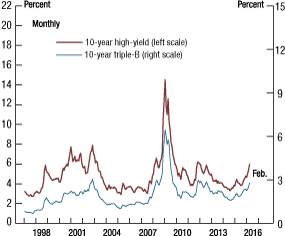
Note: The data extend through February 2016.
Source: Staff estimates based on corporate bond data from BofA Merrill Lynch Global Research (used with permission), computed using Nelson-Siegel yield curve model; semiannually compounded 10-year Treasury yield (par) estimated by Svensson term structure model.
Issuance of high-yield bonds declined steadily in 2015, particularly in the second half of the year, and issuance of leveraged loans remained stable (figure 2). As a result, issuance of risky debt in the fourth quarter of the year was close to the lowest level in recent years.
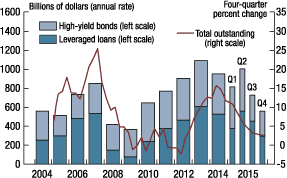
Note: Total outstanding is quarterly data, which start in 2005:Q1. Data include bonds and loans to both financial and nonfinancial companies, as well as unrated bonds and loans. For LCD and FISD, S&P and its third-party information providers expressly disclaim the accuracy and completeness of the information provided to the Board, as well as any errors or omissions arising from the use of such information. Further, the information provided herein does not constitute, and should not be used as, advice regarding the suitability of securities for investment purposes or any other type of investment advice.
Source: Standard & Poor's Leveraged Commentary & Data (LCD); Mergent Corporate Fixed Income (FISD).
Despite these signs of easing valuation pressures, there were indications that the quality of corporate debt worsened. As described in more detail later, the level of risky debt ramped up in 2015, reaching record highs. Throughout the year, the volume of nonfinancial bonds that were downgraded by Moody's Investors Service significantly outpaced that of upgrades, and a measure of expected default of nonfinancial firms, Moody's KMV, rose steadily, especially in the oil sector (figure 3). In addition, while indicators of the underwriting quality of leveraged loans showed a modest improvement, overall underwriting standards remained weak. Issuance of leveraged loans declined over the year but was robust in the first half. Market participants pointed to the leveraged lending guidance issued in 2013 as having affected the market.1 Overall, despite the recent cooling of valuation pressures, the continued growth in debt among lower-rated corporations may place strains on these firms, especially if macroeconomic conditions turn out to be weaker than expected.
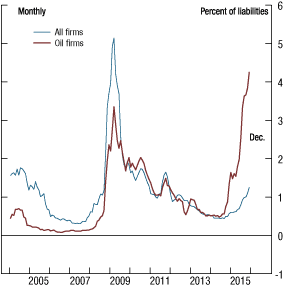
Note: The data extend through December 2015. Firm-level estimates of default weighted by firm liabilities as a percent of total liabilities, excluding defaulted firms.
Source: Moody's Analytics CreditEdge® (www.creditedge.com).
Forward price-to-earnings ratios were somewhat elevated over the year, although the equity premium, measured as the gap between the expected return on equity and the real long-term Treasury yield, is estimated to have remained near its historical norm. Although commercial real estate (CRE) lending standards did not ease, CRE prices rose and capitalization rates on CRE continued to decline, owing in part to low interest rates.2 In addition, residential real estate valuations appear within historical norms. For example, house prices relative to rents--one measure of valuations--have remained well within a typical range and continue to be far below the levels seen in the past decade across much of the country (figure 4).
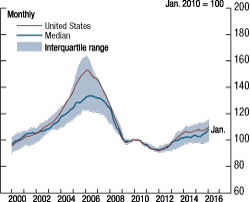
Note: The data extend through January 2016. Percentiles are based on 25 metropolitan statistical areas.
Source: For house prices, CoreLogic; for rent data, Bureau of Labor Statistics.
Leverage in the Financial System
The financial strength of the banking sector continued to improve in 2015. Banks increased their capital ratios in order to meet the new stricter regulatory requirements set by Basel III. Both the ratio of Tier 1 common equity to risk-weighted assets and the leverage ratio have continued to rise and are far above the levels seen in the mid-2000s (figure 5). The increase in capital reflects the tougher standards implemented globally as part of the Basel III process and additional efforts implemented following the passage of the Dodd-Frank Wall Street Reform and Consumer Protection Act of 2010 (Dodd-Frank Act), including more stringent standards and the annual stress tests for larger banking organizations. The Federal Reserve Board approved a final rule in July 2015 requiring the largest, most systemically important U.S. bank holding companies to further strengthen their capital positions. As discussed in more detail later, under the rule, a firm that is identified as a global systemically important bank holding company (G-SIB) will have to hold additional capital to increase its resilience in light of the greater threat it poses to the financial stability of the United States. Although delinquency rates on loans to the oil and gas industry have increased, these loans account for a small share of large banks' portfolios. Yet declining oil prices may pose a threat to the quality of the loan portfolio of small banks in some parts of the country with larger exposure to the oil industry. Overall, as a result of steady improvements in capital positions since the financial crisis, U.S. banks, in aggregate, appear to be better positioned to absorb potential shocks, such as those related to litigation, falling oil prices, and financial contagion stemming from abroad.
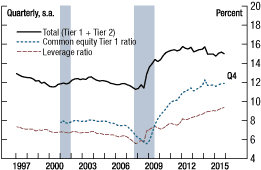
Note: Prior to 2014:Q1, the numerator of the common equity Tier 1 ratio is Tier 1 common capital. Beginning in 2014:Q1 for advanced-approaches bank holding companies (BHCs) and in 2015:Q1 for all other BHCs, the numerator is common equity Tier 1 capital. The data for the common equity Tier 1 ratio start in 2001:Q1. An advanced-approaches BHC is defined as a large internationally active banking organization, generally with at least $250 billion in total consolidated assets or at least $10 billion in total on-balance-sheet foreign exposure. The shaded bars indicate periods of business recession as defined by the National Bureau of Economic Research.
Source: Federal Reserve Board, FR Y-9C, Consolidated Financial Statements for Holding Companies.
Securitization, which continues to be an important means of financing for several asset classes, remained relatively subdued--with issuance slowing notably in the second half of 2015, particularly for asset-backed securities (ABS)--and stayed muted through year-end, as more stringent issuance requirements became effective. New issuance also involved less maturity transformation than before the crisis, as there have been no notable volumes of asset-backed commercial paper programs and issuance of ABS collateralized debt obligations, with which pre-crisis maturity transformation was largely associated. Recent results from the Federal Reserve's Senior Credit Officer Opinion Survey on Dealer Financing Terms indicate that dealers somewhat tightened conditions for the use of financial leverage by their institutional investor clients to fund the purchases of securities in the last quarter of 2015.3
Liquidity Risks and Maturity Transformation by the Financial System
Bank balance sheets show that the quality of liquidity positions remained high in 2015 as the largest BHCs transitioned to Basel III liquidity requirements. The Basel III liquidity coverage ratio (LCR) requirement began phasing in for U.S. BHCs with greater than $250 billion in consolidated assets on January 1, 2015, and will take full effect in January 2017. In January 2016, a "modified" LCR requirement for BHCs with between $50 billion and $250 billion in assets began to be phased in. Against this backdrop, balance sheet data through 2015:Q3 show that the ratio of high-quality liquid assets to total assets at large- and medium-sized BHCs remained high and well above its pre-crisis levels.
Although short-term wholesale and dealer funding remained subdued throughout 2015, in line with recent years' trends, vulnerabilities from liquidity mismatches at high-yield bond and loan mutual funds have risen somewhat. These funds have grown rapidly in recent years and now hold a much higher fraction of the available stock of relatively less liquid assets--such as high-yield corporate debt, bank loans, and international debt--than they did before the financial crisis. It is possible that, because they may appear to offer greater liquidity than the markets in which they transact, these funds may pose a threat to financial stability if large forced sales in the underlying markets are triggered by outsized investor redemptions.
The surprise suspension of redemptions by a fixed-income fund that was liquidated in December 2015 highlighted concerns about liquidity mismatches at high-yield bond mutual funds that promise daily redemptions. While net outflows from high-yield and leveraged loan funds increased notably right after the suspension on December 9, the pace of outflows has steadily slowed in subsequent weeks, suggesting that the event did not leave a lasting imprint on the broader corporate bond market (figure 6).
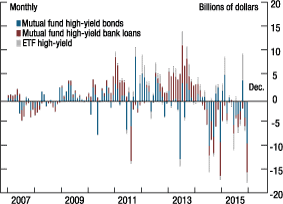
Note: The data for exchange-traded fund (ETF) high-yield flows start in
January 2011.
Source: Investment Company Institute (ICI), www.ici.org.
Borrowing by the Nonfinancial Sector
Excessive borrowing by the private nonfinancial sector has been an important contributor to financial crises in the past. Highly indebted households and nonfinancial businesses may have a difficult time withstanding negative shocks to incomes or asset values and may be forced to curtail spending in ways that amplify the effects of financial shocks. In turn, losses among households and businesses can lead to mounting losses at financial institutions, creating an "adverse feedback loop" in which weakness among households, nonfinancial businesses, and financial institutions causes further declines in income and financial losses, potentially leading to financial instability and a sharp contraction in economic activity.
Borrowing by households remained relatively subdued through 2015. At the same time, borrowing by the nonfinancial business sector grew moderately in the second half of the year. As a result, the ratio of household and nonfinancial business credit to nominal gross domestic product (GDP) has continued to grow at a rate roughly in line with nominal GDP and stayed significantly below the peak seen in the 2000s (figure 7). Nonetheless, this ratio remains above levels seen prior to the mid-2000s.
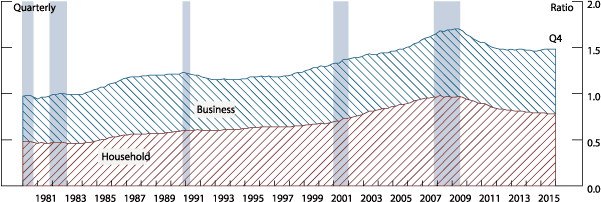
Note: GDP is gross domestic product. The shaded bars indicate periods of business recession as defined by the National Bureau of Economic Research.
Source: Federal Reserve Board, Statistical Release Z.1, "Financial Accounts of the United States."
Within the household sector, the level of borrowing edged up among households with strong credit histories, while borrowing by households with damaged credit histories--so-called subprime borrowing--contracted further, in the aggregate, in 2015. Although growth in residential real estate borrowing was moderate and driven by households with strong credit histories, there was continued and sizable growth in riskier credit segments--for example, in subprime auto lending--a trend that should be and is being monitored closely.
In the business sector, the rapid growth in borrowing in riskier segments of corporate debt markets, highlighted in the discussion of asset valuations earlier, led to a notable increase in leverage--that is, debt relative to book equity--among speculative-grade corporations, which now stands near or at multi-decade highs (figure 8). The gross leverage ratio for speculative-grade firms rose spectacularly in the oil industry, as the book value of oil-related assets was written down. As noted in the earlier discussion, oil firms experienced sharp increases in expected year-ahead default probabilities amid increased leverage and heightened volatility of their assets. However, from an economy-wide perspective, firms in the oil industry account for only about 9 percent of the total speculative-grade debt outstanding, and the expected default rates of non-oil firms increased only modestly over the same period.
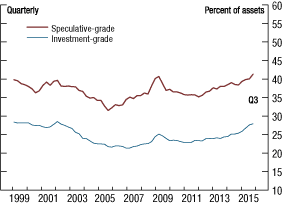
Note: The data extend through 2015:Q3. Gross leverage is the ratio of the book value of total debt to total assets. For S&P, all rights reserved. For intended recipient only. No further distribution and/or reproduction permitted.
Source: Compustat North America © 2015 Standard & Poor's Financial Services LLC ("S&P").
Macroprudential Supervision and Regulation of Large, Complex Financial Institutions
In this Section:
Large, complex financial institutions interact with financial markets and the broader economy in a manner that may--during times of stress and in the absence of an appropriate regulatory framework and effective supervision--lead to financial instability.4
Key Supervisory Activities
One important element of enhanced supervision of large banking organizations is the stress-testing process, which includes the Dodd-Frank Act stress tests (DFAST) and the Comprehensive Capital Analysis and Review (CCAR). In addition to fostering the safety and soundness of the participating institutions, stress tests embed macroprudential elements by
- examining the loss-absorbing capacity of institutions under a common macroeconomic scenario that has features similar to the strains experienced in a severe recession and which includes, as appropriate, identified salient risks;
- conducting horizontal testing across large institutions to understand the potential correlated exposures; and
- considering the effects of counterparty distress on the largest, most interconnected firms.
The results from the 2015 supervisory stress tests conducted as part of DFAST and the related CCAR were both released in March 2015.5 For DFAST 2015, the Federal Reserve conducted supervisory stress tests of 31 BHCs. The adverse and severely adverse supervisory scenarios that were used in 2015 feature U.S. and global recessions. In particular, the severely adverse scenario is characterized by a substantial global weakening in economic activity, including a severe recession in the United States, large reductions in asset prices, a significant widening of corporate bond spreads, and a sharp increase in equity market volatility. The adverse scenario is characterized by a global weakening in economic activity and an increase in U.S. inflationary pressures that, overall, result in a rapid increase in both short- and long-term U.S. Treasury rates. The results of the DFAST 2015 projections suggested that, in the aggregate, the 31 BHCs would experience substantial losses under both the adverse and the severely adverse scenarios. Over the nine quarters of the planning horizon, losses at the 31 BHCs under the severely adverse scenario were projected to be $490 billion. In CCAR 2015, the Federal Reserve did not object to the capital plan and intended capital distributions for 29 of the 31 BHCs.
Key Regulatory Activities
Over the course of 2015, the Federal Reserve has taken a number of steps to continue improving the resilience of financial institutions and the overall financial system, which are summarized as follows. First, in July, the Board finalized a rule that increases risk-based capital requirements for U.S. G-SIBs.6 The final rule establishes the procedure for identifying a G-SIB and for calculating the appropriate bank-level G-SIB surcharge. The applicable surcharges are calibrated based on the systemic footprint of each U.S. G-SIB so that the amount of additional capital a firm must hold increases with the costs that its failure would impose in terms of U.S. financial stability. The G-SIB surcharge rule is designed to ensure that U.S. G-SIBs either hold substantially more capital, reducing the likelihood that they will fail, or choose to shrink their systemic footprint, reducing the harm that their failure would do to the financial system. G-SIBs will need to become compliant by January 2019 after a transition period that is set to begin on January 1, 2016.
Second, in December 2015, the Board announced it is seeking public comment on a proposed policy statement detailing the framework the Board would follow in setting the countercyclical capital buffer (CCyB) and voted to affirm the CCyB amount at the current level of 0 percent--consistent with the continued moderate level of financial vulnerabilities.7 The buffer is a macroprudential tool that can be used to increase the resilience of the financial system by raising capital requirements on internationally active banking organizations when there is an elevated risk of above-normal losses in the future. The CCyB would then be available to help banking organizations absorb shocks associated with declining credit conditions. Implementation of the buffer could also help moderate fluctuations in the supply of credit. In releasing the framework for comment, the Board consulted with the Federal Deposit Insurance Corporation and the Office of the Comptroller of the Currency. Should the Board decide to increase the CCyB amount in the future, banking organizations would have 12 months before the change became effective, unless the Board established an earlier effective date.
Third, in October, the Board issued for public comment a proposed rule that would impose total loss-absorbing capacity and long-term debt requirements on U.S. G-SIBs and on the U.S. operations of certain foreign G-SIBs.8 The proposal would require each covered firm to maintain a minimum amount of unsecured long-term debt that could be converted into equity in a resolution of the firm, thereby recapitalizing the firm without putting public money at risk. The proposal would diminish the threat that a G-SIB's failure would pose to financial stability and is an important step in addressing the perception that certain institutions are "too big to fail." Under the proposed rule, six banks would collectively need to raise an additional $120 billion, with full compliance not required until January 2022.
Finally, the Board, acting in conjunction with other federal regulatory agencies, issued a final rule imposing minimum margin requirements on certain derivatives transactions that are not centrally cleared.9 The swap margin rule will reduce the risk that derivatives transactions would act as a channel for financial contagion and, by imposing higher margin requirements on uncleared swaps than apply to cleared swaps, will incentivize market participants to shift derivatives activity to central clearinghouses.
The enhanced prudential standards, together with stress testing and other regulatory safeguards, help ensure that large U.S. BHCs and FBOs operating in the United States have robust levels of capital and liquidity and strong risk management. Together, these efforts not only help guarantee that these firms are financially robust individually, but also limit the risk that financial distress at these firms could cause negative spillovers to the financial sector and the broader economy. Improvements in resolution planning will mitigate adverse effects from perceptions of "too big to fail" and contribute to more orderly conditions in the financial system if institutions face strains. For more information on recovery and resolution planning activity, see section 4, "Supervision and Regulation."
Domestic and International Cooperation and Coordination
In this Section:
The Federal Reserve cooperated or coordinated with both domestic and international institutions in 2015 to promote financial stability.
Financial Stability Oversight Council Activities
As mandated by the Dodd-Frank Act, the FSOC was created in 2010 and is chaired by the Treasury Secretary (box 2). It establishes an institutional framework for identifying and responding to sources of systemic risk. The Federal Reserve Chairman is a member of the FSOC.
Through collaborative participation in the FSOC, U.S. financial regulators monitor not only institutions, but the financial system as a whole. The Federal Reserve plays an important role in this macroprudential framework: It assists in monitoring financial risks, analyzes the implications of those risks for financial stability, and identifies steps that can be taken to mitigate those risks. In addition, when an institution is designated by the FSOC as systemically important, the Federal Reserve assumes responsibility for supervising that institution.
In 2015, the Federal Reserve worked, in conjunction with other FSOC participants, on the following major initiatives:
- Following up on earlier public initiatives. Such initiatives included the conference examining the asset management industry on May 19, 2014, and the request for public comments on asset management industry risks on December 18, 2014. The FSOC reviewed comment letters in response to the request for public comments, and the Federal Reserve has continued its ongoing analysis of potential risks to the financial system posed by the asset management industry. Specifically, the analysis has been focused on understanding the potential risks to the system associated with certain products and activities in the asset management industry relating to liquidity and redemptions, leverage, operational functions, and resolution.
- Adoption of changes to nonbank designations process. On February 4, 2015, the FSOC announced that it adopted changes and formalized practices relating to its process for reviewing nonbank financial companies for potential designation.10 The changes adopted fall into three broad categories:
- engagement with companies under consideration by the FSOC, which will be informed earlier when they come under review and will be provided with additional opportunities to engage with the council;
- transparency to the broader public regarding the designations process; and
- engagement during the FSOC's annual reevaluation of designations, with changes to the process for the council's annual reviews of its designations aimed at enabling more engagement between designated companies and the council and providing ample opportunity for companies to present information and to understand the council's analysis.
Box 2. Regular Reporting on Financial Stability Oversight Council Activities
The Financial Stability Oversight Council (FSOC), created under the Dodd-Frank Wall Street Reform and Consumer Protection Act of 2010 and chaired by the Secretary of the Treasury Department, meets regularly to coordinate on financial stability topics that potentially affect the U.S. economy and discloses its activities.
Monthly meeting minutes. In 2015, the FSOC met monthly, and the minutes for each meeting are available on the U.S. Treasury website (www.treasury.gov/initiatives/fsoc/council-meetings/Pages/meeting-minutes.aspx).
FSOC annual report. On May 19, 2015, the FSOC released its fifth annual report (www.treasury.gov/initiatives/fsoc/studies-reports/Pages/2015-Annual-Report.aspx), which includes a review of key developments through the beginning of 2015 and a set of recommended actions that could be taken to ensure financial stability and to mitigate systemic risks that affect the economy.
For more on the FSOC, see www.treasury.gov/initiatives/fsoc/pages/home.aspx.
Return to textFinancial Stability Board Activities
The Federal Reserve participates in international bodies, such as the FSB, given the interconnected global financial system and the global activities of large U.S. financial institutions.
The FSB is an international body that monitors the global financial system and promotes financial stability through the adoption of sound policies across countries. The Federal Reserve participates in the FSB, along with the Securities and Exchange Commission and the U.S. Treasury.11
In 2015, the Federal Reserve continued its active participation in the FSB. The FSB is engaged in several issues, including shadow banking, supervision of global systemically important financial institutions, and the development of effective resolution regimes for large financial institutions. In July, the FSB announced that it is delaying completion of the methodologies for designation of asset managers while it conducts more work on evaluating systemic risks from marketwide activities and assesses whether existing regulation is sufficient to address these risks.
References
1. For more details on the 2013 leveraged lending guidance, see Board of Governors of the Federal Reserve System (2013), "Interagency Guidance on Leveraged Lending," Supervision and Regulation Letter SR 13-3 (March 21; revised November 13, 2014), www.federalreserve.gov/bankinforeg/srletters/sr1303.htm. Return to text
2. CRE lending standards remained the focus of bank supervision, as the federal banking agencies issued on December 18, 2015, a joint statement that reinforces existing guidance for prudent risk management of CRE lending activity. The statement is available at Board of Governors of the Federal Reserve System, Federal Deposit Insurance Corporation, and Office of the Comptroller of the Currency (2015), "Agencies Issue Statement on Prudent Risk Management for Commercial Real Estate Lending," joint press release, December 18, www.federalreserve.gov/newsevents/press/bcreg/20151218a.htm. Return to text
3. The Senior Credit Officer Opinion Survey on Dealer Financing Terms is available on the Board's website at www.federalreserve.gov/econresdata/releases/scoos.htm. Return to text
4. For more on the Federal Reserve's supervision and regulation of large institutions, and especially related to the integration of the microprudential objective of safety and soundness of individual institutions with the macroprudential efforts outlined later in this section, see section 4, "Supervision and Regulation." Return to text
5. For additional information on DFAST, see Board of Governors of the Federal Reserve System (2015), Dodd-Frank Act Stress Test 2015: Supervisory Stress Test Methodology and Results (Washington: Board of Governors, March), www.federalreserve.gov/newsevents/press/bcreg/bcreg20150305a1.pdf.
For more details on CCAR, see Board of Governors of the Federal Reserve System (2015), Comprehensive Capital Analysis and Review 2015: Assessment Framework and Results (Washington: Board of Governors, March), www.federalreserve.gov/newsevents/press/bcreg/bcreg20150311a1.pdf. Return to text
6. For more information, see Board of Governors of the Federal Reserve System (2015), "Federal Reserve Board Approves Final Rule Requiring the Largest, Most Systemically Important U.S. Bank Holding Companies to Further Strengthen Their Capital Positions," press release, July 20, www.federalreserve.gov/newsevents/press/bcreg/20150720a.htm. See also Board of Governors of the Federal Reserve System (2015), "Calibrating the GSIB Surcharge," white paper (Washington: Board of Governors, July), www.federalreserve.gov/aboutthefed/boardmeetings/gsib-methodology-paper-20150720.pdf. Return to text
7. Details on the proposed framework are available at Board of Governors of the Federal Reserve System (2015), "Federal Reserve Board Seeks Public Comment on Proposed Policy Statement Detailing the Framework the Board Would Follow in Setting the Countercyclical Capital Buffer (CCyB)," press release, December 21, www.federalreserve.gov/newsevents/press/bcreg/20151221b.htm. Return to text
8. See Board of Governors of the Federal Reserve System (2015), "Federal Reserve Board Proposes New Rule to Strengthen the Ability of Largest Domestic and Foreign Banks Operating in the United States to Be Resolved without Extraordinary Government Support or Taxpayer Assistance," press release, October 30, www.federalreserve.gov/newsevents/press/bcreg/20151030a.htm. For additional information, see Board of Governors of the Federal Reserve System (2015), "Total Loss-Absorbing Capacity, Long-Term Debt, and Clean Holding Company Requirements for Systemically Important U.S. Bank Holding Companies and Intermediate Holding Companies of Systemically Important Foreign Banking Organizations; Regulatory Capital Deduction for Investments in Certain Unsecured Debt of Systemically Important U.S. Bank Holding Companies," notice of proposed rulemaking (Docket No. R-1523), Federal Register, vol. 80 (November 30), pp. 74926-64, www.gpo.gov/fdsys/pkg/FR-2015-11-30/pdf/2015-29740.pdf. Return to text
9. See Board of Governors of the Federal Reserve System, Federal Deposit Insurance Corporation, Office of the Comptroller of the Currency, Farm Credit Administration, and Federal Housing Finance Agency (2015), "Agencies Finalize Swap Margin Rule," joint press release, October 30, www.federalreserve.gov/newsevents/press/bcreg/20151030b.htm. Return to text
10. For more information, see U.S. Department of the Treasury (2015), "Financial Stability Oversight Council Announces Changes to Nonbank Designations Process," press release, February 4, www.treasury.gov/press-center/press-releases/Pages/jl9766.aspx. Return to text
11. See the Financial Stability Board website at www.financialstabilityboard.org ![]() . Return to text
. Return to text
